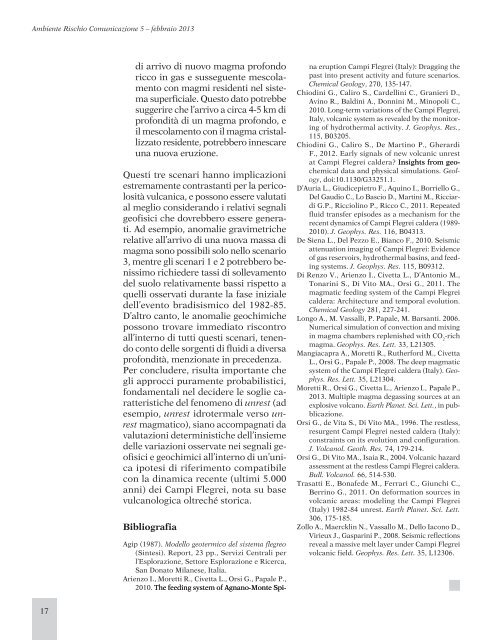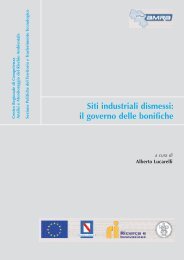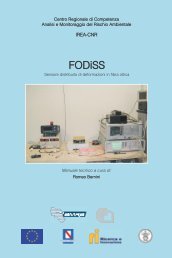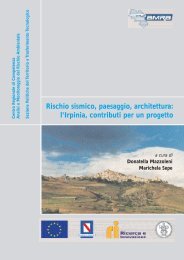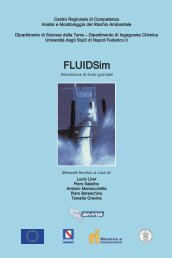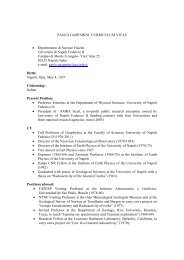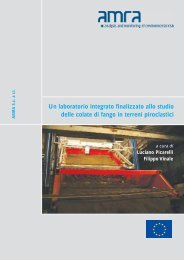scarica l'ultimo numero "Che succede ai Campi Flegrei?" - Amra
scarica l'ultimo numero "Che succede ai Campi Flegrei?" - Amra
scarica l'ultimo numero "Che succede ai Campi Flegrei?" - Amra
Create successful ePaper yourself
Turn your PDF publications into a flip-book with our unique Google optimized e-Paper software.
Ambiente Rischio Comunicazione 5 – febbr<strong>ai</strong>o 2013<br />
17<br />
di arrivo di nuovo magma profondo<br />
ricco in gas e susseguente mescolamento<br />
con magmi residenti nel sistema<br />
superficiale. Questo dato potrebbe<br />
suggerire che l’arrivo a circa 4-5 km di<br />
profondità di un magma profondo, e<br />
il mescolamento con il magma cristallizzato<br />
residente, potrebbero innescare<br />
una nuova eruzione.<br />
Questi tre scenari hanno implicazioni<br />
estremamente contrastanti per la pericolosità<br />
vulcanica, e possono essere valutati<br />
al meglio considerando i relativi segnali<br />
geofisici che dovrebbero essere generati.<br />
Ad esempio, anomalie gravimetriche<br />
relative all’arrivo di una nuova massa di<br />
magma sono possibili solo nello scenario<br />
3, mentre gli scenari 1 e 2 potrebbero benissimo<br />
richiedere tassi di sollevamento<br />
del suolo relativamente bassi rispetto a<br />
quelli osservati durante la fase iniziale<br />
dell’evento bradisismico del 1982-85.<br />
D’altro canto, le anomalie geochimiche<br />
possono trovare immediato riscontro<br />
all’interno di tutti questi scenari, tenendo<br />
conto delle sorgenti di fluidi a diversa<br />
profondità, menzionate in precedenza.<br />
Per concludere, risulta importante che<br />
gli approcci puramente probabilistici,<br />
fondamentali nel decidere le soglie caratteristiche<br />
del fenomeno di unrest (ad<br />
esempio, unrest idrotermale verso un<br />
rest magmatico), siano accompagnati da<br />
valutazioni deterministiche dell’insieme<br />
delle variazioni osservate nei segnali geofisici<br />
e geochimici all’interno di un’unica<br />
ipotesi di riferimento compatibile<br />
con la dinamica recente (ultimi 5.000<br />
anni) dei <strong>Campi</strong> <strong>Flegrei</strong>, nota su base<br />
vulcanologica oltreché storica.<br />
Bibliografia<br />
Agip (1987). Modello geotermico del sistema flegreo<br />
(Sintesi). Report, 23 pp., Servizi Centrali per<br />
l’Esplorazione, Settore Esplorazione e Ricerca,<br />
San Donato Milanese, Italia.<br />
Arienzo I., Moretti R., Civetta L., Orsi G., Papale P.,<br />
2010. The feeding system of Agnano-Monte Spi- Spi-<br />
na eruption <strong>Campi</strong> <strong>Flegrei</strong> (Italy): Dragging the<br />
past into present activity and future scenarios.<br />
<strong>Che</strong>mical Geology, 270, 135-147.<br />
Chiodini G., Caliro S., Cardellini C., Granieri D.,<br />
Avino R., Baldini A., Donnini M., Minopoli C.,<br />
2010. Long-term variations of the <strong>Campi</strong> <strong>Flegrei</strong>,<br />
Italy, volcanic system as revealed by the monitoring<br />
of hydrothermal activity. J. Geophys. Res.,<br />
115, B03205.<br />
Chiodini G., Caliro S., De Martino P., Gherardi<br />
F., 2012. Early signals of new volcanic unrest<br />
at <strong>Campi</strong> <strong>Flegrei</strong> caldera? Insights from geo- geochemical<br />
data and physical simulations. Geol<br />
ogy, doi:10.1130/G33251.1.<br />
D’Auria L., Giudicepietro F., Aquino I., Borriello G.,<br />
Del Gaudio C., Lo Bascio D., Martini M., Ricciardi<br />
G.P., Ricciolino P., Ricco C., 2011. Repeated<br />
fluid transfer episodes as a mechanism for the<br />
recent dynamics of <strong>Campi</strong> <strong>Flegrei</strong> caldera (1989-<br />
2010). J. Geophys. Res. 116, B04313.<br />
De Siena L., Del Pezzo E., Bianco F., 2010. Seismic<br />
attenuation imaging of <strong>Campi</strong> <strong>Flegrei</strong>: Evidence<br />
of gas reservoirs, hydrothermal basins, and feeding<br />
systems. J. Geophys. Res. 115, B09312.<br />
Di Renzo V., Arienzo I., Civetta L., D’Antonio M.,<br />
Tonarini S., Di Vito MA., Orsi G., 2011. The<br />
magmatic feeding system of the <strong>Campi</strong> <strong>Flegrei</strong><br />
caldera: Architecture and temporal evolution.<br />
<strong>Che</strong>mical Geology 281, 227-241.<br />
Longo A., M. Vassalli, P. Papale, M. Barsanti. 2006.<br />
Numerical simulation of convection and mixing<br />
in magma chambers replenished with CO -rich 2<br />
magma. Geophys. Res. Lett. 33, L21305.<br />
Mangiacapra A., Moretti R., Rutherford M., Civetta<br />
L., Orsi G., Papale P., 2008. The deep magmatic<br />
system of the <strong>Campi</strong> <strong>Flegrei</strong> caldera (Italy). Geo<br />
phys. Res. Lett. 35, L21304.<br />
Moretti R., Orsi G., Civetta L., Arienzo I., Papale P.,<br />
2013. Multiple magma degassing sources at an<br />
explosive volcano. Earth Planet. Sci. Lett., in pubblicazione.<br />
Orsi G., de Vita S., Di Vito MA., 1996. The restless,<br />
resurgent <strong>Campi</strong> <strong>Flegrei</strong> nested caldera (Italy):<br />
constr<strong>ai</strong>nts on its evolution and configuration.<br />
J. Volcanol. Geoth. Res. 74, 179-214.<br />
Orsi G., Di Vito MA., Is<strong>ai</strong>a R., 2004. Volcanic hazard<br />
assessment at the restless <strong>Campi</strong> <strong>Flegrei</strong> caldera.<br />
Bull. Volcanol. 66, 514-530.<br />
Trasatti E., Bonafede M., Ferrari C., Giunchi C.,<br />
Berrino G., 2011. On deformation sources in<br />
volcanic areas: modeling the <strong>Campi</strong> <strong>Flegrei</strong><br />
(Italy) 1982-84 unrest. Earth Planet. Sci. Lett.<br />
306, 175-185.<br />
Zollo A., Maercklin N., Vassallo M., Dello Iacono D.,<br />
Virieux J., Gasparini P., 2008. Seismic reflections<br />
reveal a massive melt layer under <strong>Campi</strong> <strong>Flegrei</strong><br />
volcanic field. Geophys. Res. Lett. 35, L12306.


